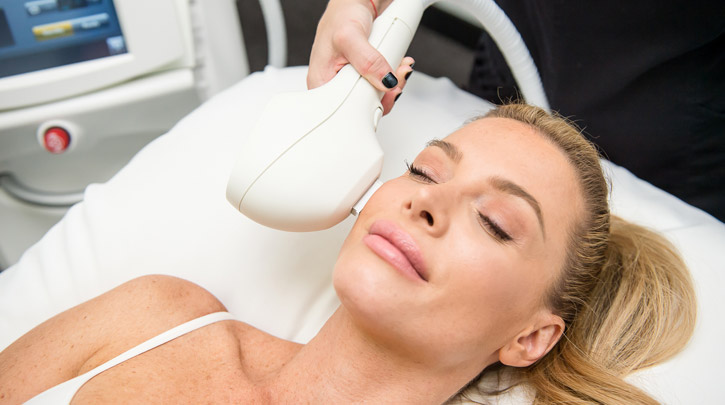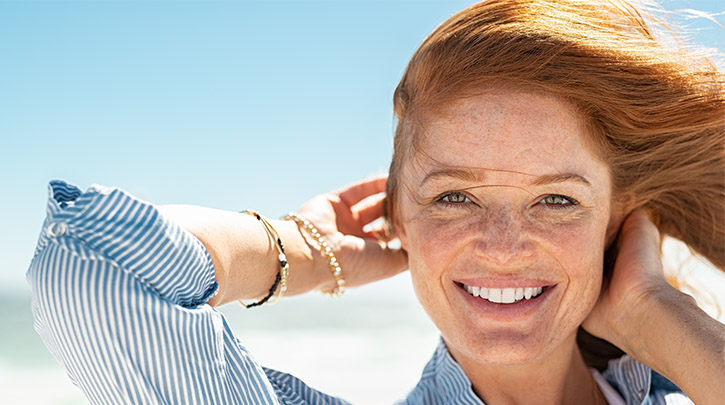
- Global
Get non-surgical solutions for today's top aesthetic concerns with Venus Treatments. Join thousands of satisfied patients worldwide!
- Loading...
- All Regions
Get non-surgical solutions for today's top aesthetic concerns with Venus Treatments. Join thousands of satisfied patients worldwide!

Dark spots, age spots, sunspots, liver spots, freckles, hyperpigmentation patches—the names for skin spots are seemingly endless, and unfortunately, the list of causes behind these pesky patches is just as long and varied. What causes one person’s brown spots may have nothing to do with why another person has them. However, there are some more common causes to keep an eye on for prevention and reduction.
There’s truth behind the term “sunspots,” since sun exposure is one common cause of brown spots. UVA and UVB rays (two variants of ultraviolet light from the sun) penetrate the skin and cause a spike in melanin production. This is the skin’s way of preventing further damage, as melanin absorbs and scatters UV radiation. That’s why folks with naturally darker skin tend to burn less often than those with lower melanin levels. However, with time and added sun exposure, people without naturally melanin-rich skin will see that darker pigment appears to clump together and gathers at the skin’s surface, resulting in the appearance of those pesky sunspots. The solution to developing more sunspots is simple: wear broad-spectrum sunscreen and minimize your exposure.
Even in winter months, applying proper SPF protection before heading outdoors should be a daily habit. The sun’s rays are actually amplified when there is snow around, exposing us to almost double the UV rays as they are reflected off the snow. The higher the elevation, the higher the UV radiation. To be exact, for every additional 1000 feet in elevation, UV radiation increases by 5%. Therefore, make sure you prepare ample sun protection for your next ski adventure!
The sun isn’t the only source of UV radiation. While UVA and UVB are fairly familiar, particularly during the summertime when sun safety becomes an even hotter topic, there’s a little-known third type of ultraviolet light to be wary of: UVC. Usually scattered by wind and air, UVC rays from the sun aren’t a major concern. However, a study published in the scientific journal Photochemistry and Photobiology reported that some worn fluorescent bulbs produce high levels of UVC that can cause hyperpigmentation (and even skin cancer) with extended exposure over time. The culprit: a worn-off phosphor coating that’s common when older bulbs go unchecked. Keep a closer eye on table or desk lamps using fluorescent bulbs and older tanning bulbs, or simply ditch the fluorescent bulbs in favor of LEDs. However, if you’re stuck with fluorescents, which is one of the ways that your skin ages indoors, then it might be wise to start wearing sunscreen if you’re sitting at your desk all day.
Another factor wreaking havoc on melanin production is a fluctuation in hormone levels. The key hormones that can affect your skin are testosterone, estrogen, androgens, triiodothyronine, and thyroxine. Birth control, stress, menopause, pregnancy, and some medications cause fluctuations in estrogen and progesterone specifically, two hormones known to spike melanin production when they’re found at higher levels. This can cause melasma, a form of hyperpigmentation characterized by brown splotches on the face, hands, and pretty much anywhere else on the body. The American Academy of Dermatology reports that more than five million Americans have melasma. It is most commonly known to affect those with Fitzpatrick skin types 3-6. The best bet is to try natural alternatives to even out hormone levels when possible and use natural creams, serums, or treatments, when safe, to reduce the appearance of brown spots.
Advanced age sounds nicer than old age, but the point remains: the greater the years, the greater the brown spots that appear. This goes back to the points about hormones, sun exposure, and the clumping of melanin over time. Add to that the decline in elastin and collagen production, and the skin’s loss of natural volume and color with age, and we have a more pronounced appearance of existing age spots.
For the most part, the appearance of many brown spots can be faded through a variety of topical and treatment options. Look for topical anti-aging creams and serums that contain soy, kojic acid, niacinamide, ellagic acid, and liquorice, among other ingredients, to help break down those odd spots of discoloration and even out skin pigment.
If your skin naturally has relatively little melanin (lighter skin types), Intense Pulsed Light (IPL) treatments are your best bet for fading the occasional brown spot. These treatments (often called “photofacials,” meaning facial treatments using light) deliver bursts of light to multiple layers of the skin to target and zap the pockets of melanin that create those spots and blotches.
However, if your skin is naturally high in melanin then IPL treatments can have the opposite effect: talk to a treatment provider to get more info so you can make the right choice for your skin health.
To learn more about photofacial treatments or to book a consultation today, locate a certified treatment provider using the search field below.
Find a certified Venus Treatments provider near you today who specializes in today’s top aesthetic medical solutions.



Search below to find a provider near you and to learn about our non-surgical aesthetic treatments with ARTAS®, NeoGraft®, Venus Bliss™, Venus Blilss MAX™, Venus Versa™, Venus Legacy™ Venus Versa™ Pro, Venus Velocity™, Venus Viva™ MD, and Venus Glow™.
For more information call: (888) 907-0115 // [email protected] // 235 Yorkland Blvd., Suite 900, Toronto, ON, M2J 4Y8 Canada
REGULATORY CLEARANCES [ More ]
Venus Bliss™ is cleared by the FDA and licensed by Health Canada for non-invasive lipolysis of the abdomen and flanks in individuals with a Body Mass Index (BMI) of 30 or less, with the diode laser applicators. The (MP)2 applicator is cleared by the FDA for temporary reduction in the appearance of cellulite, and licensed by Health Canada for temporary increase of skin tightening, temporary circumferential reduction, and temporary cellulite reduction. Venus Bliss™ has CE Mark as a non-invasive medical aesthetic device enabling a comprehensive approach leading to body contouring, addressing fat reduction, skin tightening, circumference reduction, and cellulite reduction.
Venus Versa™ is cleared by the FDA, licensed by Health Canada, and has CE Mark as a multi-application device intended to be used in aesthetic and cosmetic procedures. The SR515 and SR580 applicators are cleared by the FDA, licensed by Health Canada, and have CE Mark for the treatment of benign pigmented epidermal and cutaneous lesions and treatment of benign cutaneous vascular lesions. The HR650/HR650XL and HR690/HR690XL applicators are cleared by the FDA, licensed by Health Canada, and have CE Mark for the removal of unwanted hair and to effect stable long-term or permanent hair reduction for Fitzpatrick skin types I-IV. The AC Dual applicator is cleared by the FDA, licensed by Health Canada, and has CE Mark for the treatment of acne vulgaris. The DiamondPolar™ and OctiPolar™ applicators on the Venus Versa™ system are cleared by the FDA for non-invasive treatment of moderate to severe facial wrinkles and rhytides on females with Fitzpatrick skin types I-IV. The DiamondPolar™ applicator is licensed by Health Canada and has CE Mark for non-invasive treatment of moderate to severe facial wrinkles and rhytides on females with Fitzpatrick skin types I-IV. The OctiPolar™ applicator on the Venus Versa™ system is licensed by Health Canada and has CE Mark for temporary body contouring via skin tightening, circumferential reduction, and cellulite reduction. The NanoFractional RF™ (Viva) applicator is cleared by the FDA, licensed by Health Canada, and has CE Mark for dermatological procedures requiring ablation and resurfacing of the skin.
NeoGraft® is cleared by the FDA, licensed by Health Canada and has CE Mark with indication for use in suction-assisted follicular extraction and re-implantation. It is an auto-graft system and can be used on both male and female patients.
ARTAS iX™ is cleared by the FDA, licensed by Health Canada and has CE Mark with indication for use for harvesting hair follicles from the scalp in men diagnosed with androgenic alopecia (male pattern hair loss) who have black or brown straight hair. ARTAS iX™ is intended to assist physicians in identifying and extracting hair follicular units from the scalp during hair transplantation; creating recipient sites; and implanting harvested hair follicles.
Venus Legacy™ is cleared by the FDA for the non-invasive treatment of moderate to severe facial wrinkles and rhytides in females with Fitzpatrick skin types I-IV with the OctiPolar™ and DiamondPolar™ applicators, and temporary reduction in the appearance of cellulite with the 4D Body (LB2) and 4D Face (LF2) applicators. It is licensed by Health Canada and has CE Mark for the temporary increase of skin tightening, temporary circumferential reduction, temporary cellulite reduction, and temporary wrinkle reduction.
Venus Velocity™ is cleared by the FDA, licensed by Health Canada and has CE Mark for hair removal, permanent hair reduction (defined as the long-term stable reduction in the number of hairs re-growing when measured at 6, 9 and 12 months after the completion of a treatment regimen), and the treatment of pseudofolliculitis barbae for all Fitzpatrick skin types.
Venus Fiore™ received regulatory approval in Israel for aesthetic and functional treatment of the vagina, labia and mons pubis. Venus Fiore™ is available for sale in India, Hong Kong, and other selected Asian countries.
Venus Viva™ is cleared by the FDA, licensed by Health Canada, and has CE Mark for dermatological procedures requiring ablation and resurfacing of the skin. The DiamondPolar™ applicator is cleared by the FDA, licensed by Health Canada and has CE Mark for the treatment of moderate to severe wrinkles and rhytides in Fitzpatrick skin types I-IV.
Venus Freeze Plus™ is cleared by the FDA for the non-invasive treatment of moderate to severe facial wrinkles and rhytides in females with Fitzpatrick skin types I-IV. It is licensed by Health Canada for temporary skin tightening, and temporary reduction in the appearance of cellulite on the abdomen and flanks, using the DiamondPolar™ and OctiPolar™ applicators. The DiamondPolar™ applicator on Venus Freeze Plus™ has CE Mark for the non-invasive treatment of moderate to severe facial wrinkles and rhytides, and the increase of skin tightening, temporary circumferential reduction, and cellulite reduction with the OctiPolar™ applicator.
Venus Heal™ is licensed by Health Canada and can be used for the treatment of both acute and chronic disorders of the musculoskeletal system, such as muscle spasms, back pain, and soft tissue injuries, and results in effects such as pain relief, myorelaxation, increase of local blood circulation, and edema reduction. In the U.S., Venus Heal™ is cleared by the FDA for the relief of minor muscle aches and pain, relief of muscle spasm, and temporary improvement of local blood circulation. These indications enable the treatment of certain soft tissue injuries and conditions.
Venus Glow™ is cleared by the FDA as a Class I motorized dermabrasion device. It provides a dermal rejuvenation treatment that works to open up and deep-clean pores. Venus Concept is the exclusive distributor for Venus Glow™.
Venus Epileve™ is licensed by Health Canada and has CE Mark for hair removal, permanent hair reduction (defined as the long-term stable reduction in the number of hairs re-growing when measured at 6, 9 and 12 months after the completion of a treatment regimen), and the treatment of pseudofolliculitis barbae for all Fitzpatrick skin types. Venus Epileve™ is also CE-Marked for hirsutism.
Venus Freeze™ is cleared by the FDA for the non-invasive treatment of moderate to severe facial wrinkles and rhytides in females with Fitzpatrick skin types I-IV. It is licensed by Health Canada for temporary skin tightening, and temporary reduction in the appearance of cellulite on the abdomen and flanks, using the DiamondPolar™ and OctiPolar™ applicators. The DiamondPolar™ applicator on Venus Freeze™ has CE Mark for the non-invasive treatment of moderate to severe facial wrinkles and rhytides, and the increase of skin tightening, temporary circumferential reduction, and cellulite reduction with the OctiPolar™ applicator.
Venus Swan™ is cleared by the FDA for the non-invasive treatment of moderate to severe facial wrinkles and rhytides, and licensed by Health Canada for the non-invasive treatment of cellulite reduction, skin tightening, and temporary reduction in the appearance of stretch marks.
Copyright © 2025 Venus Concept. All rights reserved.
You are entering our website. For other countries/regions and language options, please click the SELECT A DIFFERENT REGION button below.
SELECT A DIFFERENT REGIONAre you looking to get a treatment? Please visit our patient website to learn more.
Click HereUnsure which aesthetic treatment is right for you? Take this quick and easy quiz to discover treatments that suit your needs.
Get Started